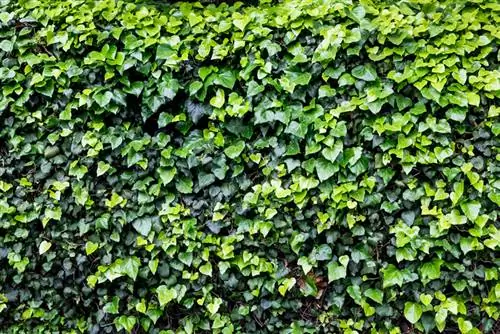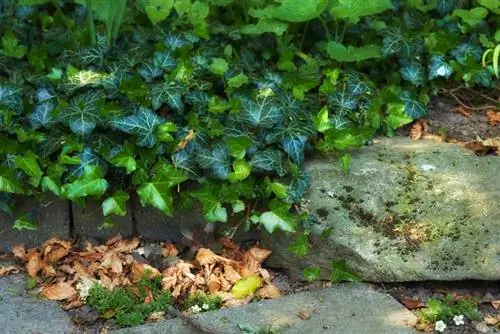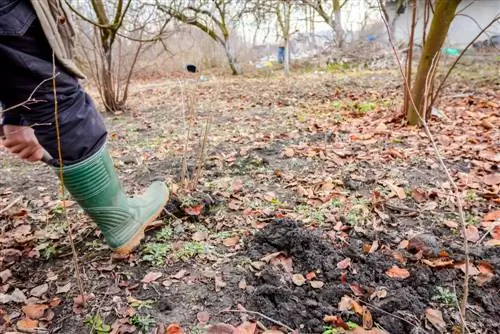- Author admin [email protected].
- Public 2023-12-16 16:46.
- Last modified 2025-01-23 11:20.
Ivy is one of the plants in the garden that spreads extremely quickly. They take over large areas, climbing along house walls and walls or growing up trees. Ivy can cause considerable damage if left unchecked. Tips and tricks on how to permanently remove ivy.

How can you remove ivy effectively and permanently?
To permanently remove ivy, cut off shoots and tendrils, carefully pull roots from walls or trees, and remove all roots from the ground. Chemical agents such as Roundup are not recommended as they do not have a lasting effect and can damage other plants.
When do you need to remove ivy?
The shoots of the ivy can cause significant damage to masonry. They get stuck in joints and holes and expand them.
Trees, even large old ones, can be so crushed by the ivy vines that they die.
It can therefore make sense not to let ivy grow too much and to free masonry and other plants from the tendrils.
What is important when fighting ivy?
Ivy spreads via the shoots on which adherent roots develop. The adhesive roots bury themselves in everything that gives them support:
- Earth
- Wooden walls
- Masonry
- Trees
Even small ivy residues quickly form new offshoots. If you want to remove ivy permanently, you must ensure that all shoots and roots are carefully removed from floors, walls or other surfaces.
How to remove ground cover ivy
If the ivy has overgrown a larger area as a ground cover, it is best to start removing the plants at the edge. If possible, cut off all the thicker shoots that you can reach with pruning shears (€13.00 on Amazon) or a small saw. Pull out the vines and make sure to grab as many roots as possible. Once the area above ground is cleared of ivy, you need to get the roots out of the soil. If necessary, moisten the soil as this will make the work easier.
Prick the ground with a digging fork and lift the soil. You can often simply pull out the roots. With very old ivy plants, however, the only option is to grab a spade and dig out the roots.
Removing ivy from walls and house walls
If the ivy has climbed up walls and walls, the damage caused can be considerable. To avoid making things worse, you need to proceed carefully. This is especially true if the ivy roots have burrowed into joints.
Wet the wall with the ivy. Always start from above to carefully pull the long tendrils out of the masonry. If thicker shoots cannot be pulled out, cut them into smaller pieces with secateurs. You then have to dig up the roots of the ivy so that it doesn't sprout again.
Once the wall is free of ivy, scrub it with a solution of dish soap and water using a stiff brush. This not only serves the purpose of getting the masonry clean again, you also remove any remaining ivy root residue.
Removing ivy from trees
If a tree is overgrown with ivy, first check how he althy the tree is. If it can't be saved anyway, you can save yourself the work.
To remove ivy from a tree, cut through all the ivy shoots at a height of approximately 1.50 meters and pull them downwards. This is easier when the tree is moist. If necessary, you should hose it down with water first. The upper tendrils can remain on the tree if they are not too thick and the roots have not penetrated too deeply into the tree bark. These shoots dry up and then fall off.
Then you have to dig up all the roots of the ivy around the tree.
Can ivy be removed with Roundup?
When the ivy population gets out of hand, many garden owners resort to chemical agents such as Roundup or glyphosate. Even if it looks simple on the packaging, these products are not permanently effective and are not recommended due to their high toxicity to other plants.
With Roundup and other products you can ensure that the leaf masses die off at the top and some of the small adhesive roots are also destroyed. However, you won't be able to reach deep roots with this. The ivy sprouts again, so that after a while you are faced with the same problem again.
Protect hands and respiratory tract from ivy
Since ivy is poisonous and even contact with bare skin can cause skin inflammation, always work with gloves when removing ivy.
Even the smallest particles released during cutting can be harmful if they enter the respiratory tract. It is therefore advisable to wear a respiratory mask when carrying out this work.
Tip
Never leave ivy cuttings and roots lying around, but dispose of them as soon as possible. Otherwise there is a risk of poisoning for pets. In addition, new adhesive roots form on the cut shoots, through which the ivy spreads again in the garden.






